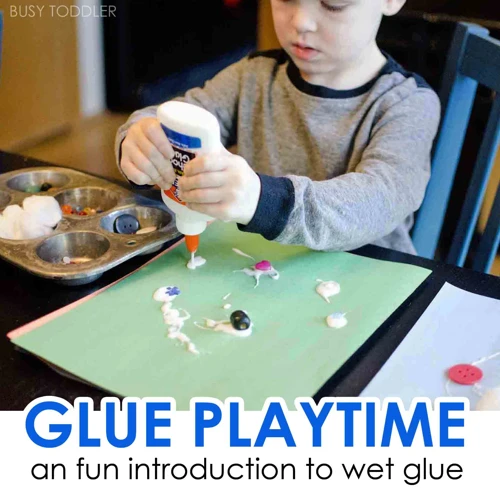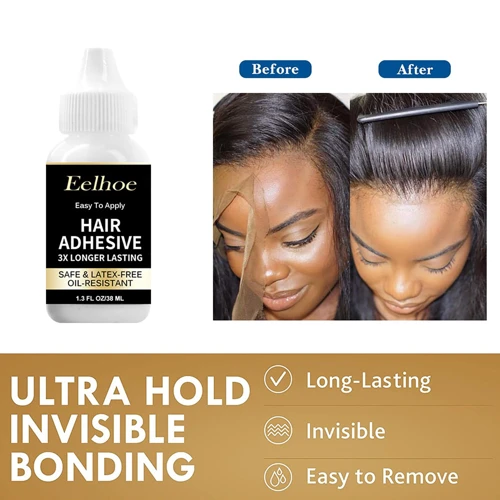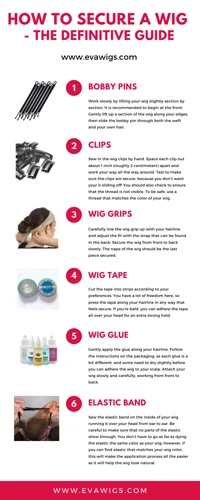Introduction
When it comes to wearing wigs, most people resort to using glue to hold the wig in place. However, using glue can be messy and sometimes even damaging to both your hairline and the wig itself. Fortunately, there are ways to wear a wig without glue. Not only is this method less messy, but it also gives you more versatility and allows you to take better care of your wig. In this comprehensive guide, we’ll show you step-by-step how to wear a wig without glue, from prepping your hair and wig to styling and caring for it. So, if you’re ready to switch to a glue-free wig wearing method, keep reading!
Why No-Glue Wig Wearing is Best
No-Glue Wig Wearing is a safe and convenient approach to styling your hair with a wig. Using wig glue for a secure fit can often lead to hair breakage and scalp damage. By avoiding the use of wig glue, you can ensure your natural hair remains healthy and undamaged. When you use wig glue, it can be a hassle to remove and can leave behind residue, which can be harmful to your natural hair.
Instead, by using alternative methods of securing your wig, you can easily remove and adjust your wig without damaging your hair. This also saves you time and money by avoiding costly hair treatments that are necessary to repair glue-related damage.
Using a no-glue method of wearing a wig is versatile and widely accessible. Whether you have short, long, or thick hair, you can easily pull off a wig without damaging your hair. This method is often perfect for people who switch hairstyles frequently, as it provides the flexibility to take on different looks without harming your natural hair.
There are plenty of benefits to using a no-glue method when it comes to wearing wigs. With a no-glue approach, you can keep your natural hair healthy, save time and money, and enjoy an easy and versatile styling experience. If you’re interested in learning more about the use of wig glue, you can check out “What is Wig Glue?” for more information.
Prepping Your Hair and Wig
Strong and healthy natural hair is the foundation of any wig install. Prepping your hair and wig before placing it on your head will ensure a flawless and long-lasting look. In this section, we’ll discuss how to properly clean your hair and wig, as well as how to prepare your wig for a no-glue application. By following these steps, you’ll guarantee that your wig stays in place without causing any damage to your natural hair. And if you still prefer to wear a glued wig, check out our guide on how to make a wig with glue.
Washing Your Hair
When it comes to wearing a wig without glue, it’s crucial to properly prep your natural hair. One important step is washing your hair. It’s essential to have clean hair before wearing a wig, as a dirty scalp can lead to discomfort, irritation, and even infection. Here are some tips on how to wash your hair before putting on a wig without glue:
| Action | Details |
|---|---|
| Pre-Wash Treatment | Apply a pre-wash treatment to your hair and scalp. This can be a hair mask, oil treatment, or even a clarifying shampoo. This will help to remove any product buildup or residue from your hair and scalp, leaving it clean and refreshed. |
| Washing Frequency | Wash your hair no more than once a week. Over-washing can strip your scalp of natural oils, leaving it dry and flaky. This can lead to itching and discomfort when wearing a wig. It’s important to maintain a healthy balance of natural oils in your scalp by not over-washing. |
| Shampoo Selection | Select a gentle, sulfate-free shampoo. Sulfates can be harsh on your hair and scalp, leading to dryness and irritation. You want to use a shampoo that is gentle enough for daily use and won’t cause any adverse reactions. |
| Water Temperature | Use lukewarm water to wash your hair. Water that is too hot can damage your hair and scalp, leading to dryness and breakage. Lukewarm water is gentle on your hair and scalp and will help to prevent any damage. |
| Scalp Massage | Gently massage your scalp while washing your hair. This will help to stimulate blood flow and promote healthy hair growth. It will also help to remove any dirt or debris from your scalp, leaving it clean and refreshed. |
| Rinse Thoroughly | Rinse your hair thoroughly. Make sure to remove all shampoo and conditioner from your hair, as any leftover residue can cause itchiness and discomfort when wearing a wig. |
Keep in mind that these tips are just a basic guide for washing your hair before wearing a wig without glue. It’s important to consider your specific hair type and any allergies or sensitivities you may have when selecting your products and following a hair-washing routine. For more information on how to wear a wig without glue and properly prep your hair, check out our article How to Wear a Wig Without Glue: A Comprehensive Guide.
Prepping Your Wig
Preparing your wig before wearing it is crucial to ensure a natural look and comfortable fit. Here are the steps you can follow to prep your wig:
- Detangle: Before wearing your wig, make sure to detangle it thoroughly. Comb gently with a wig comb, starting from the ends and working your way up towards the roots.
- Trim: If the wig has excess lace, trim it to fit your hairline. Be careful not to cut the hairs of the wig while doing this.
- Adjust: Most wigs come with adjustable straps at the back. Adjust these straps to fit your head comfortably. This will prevent the wig from slipping or feeling too tight.
- Cut the lace: If you are wearing a lace front wig, you will need to cut the lace to fit your hairline. Use a small pair of scissors to cut the lace, being careful not to cut into the hair of the wig. For a more detailed guide on how to cut the lace, check out this article.
- Apply baby powder: Applying a small amount of baby powder to the inside of the wig can help reduce shine and make the wig more comfortable to wear.
- Use hairspray: Using a light hold hairspray on your wig can help keep it in place throughout the day. For a stronger hold, check out this guide on how to use hair glue.
By following these steps, you can ensure that your wig is comfortable, secure, and looks natural. If you decide to use hair glue or other adhesive products, make sure to check out our article on how to protect your hair from damage.
Securing Your Wig
When it comes to wearing a wig, one of the biggest concerns for many people is how to keep it securely in place without using glue. Luckily, there are several alternative methods for securing your wig that do not involve the use of potentially damaging adhesives. Below are some of the most effective ways to keep your wig in place without glue.
If you are interested in using hair glue for other purposes, check out our article on how to make hair glue. If you are considering a lace frontal sew-in but unsure how long it will last without glue, read our informative guide. Or, if you’re feeling crafty and want to know how to glue rhinestones on your hair, we’ve got you covered. Check out our helpful article. And if you’re wondering about the difference between glueless and glue lace wigs, we have an article on that too! Find out more here.
Using Wig Clips
When it comes to securing your wig without using glue, there are a few options to choose from. One of the most popular options is using wig clips. These small clips are easy to use and are a great way to keep your wig in place throughout the day. Here’s how to use them:
Step 1: First, prepare your hair by pulling it back into a tight ponytail or braiding it close to your head. This will help ensure a smooth surface for the wig cap to rest on.
Step 2: Next, put on your wig cap and adjust it so that it sits comfortably on your head. Make sure the wig cap is snug but not too tight.
Step 3: Now it’s time to add the wig clips. You’ll want to place the clips at the temples, the top of the ears, and the nape of the neck. There are typically four to six clips included with a wig.
Step 4: To attach the clips, open the clip and position it so that the teeth are facing towards your head. Then, snap the clip shut. Repeat this process for the other clips.
Step 5: Once all the clips are in place, adjust the wig as needed. You can gently tug on the wig to make sure it’s secure, and use bobby pins or more clips if needed.
Using wig clips is a great option for those who want to wear a wig without using glue. They are easy to use, affordable, and offer a secure hold. Just make sure to properly prep your hair and wig before securing it with clips to ensure the best fit and look.
| Steps | Instructions |
|---|---|
| Step 1 | Prepare your hair by pulling it back into a tight ponytail or braiding it close to your head. |
| Step 2 | Put on your wig cap and adjust it so that it sits comfortably on your head. |
| Step 3 | Place the wig clips at the temples, the top of the ears, and the nape of the neck. |
| Step 4 | Open the clip and position it so that the teeth are facing towards your head. Then, snap the clip shut. |
| Step 5 | Adjust the wig as needed and use bobby pins or more clips if necessary for extra security. |
Using Bobby Pins
When it comes to securing your wig without any adhesive, bobby pins are a fantastic option. They’re easy to use and affordable, making them a popular choice among wig wearers.
Here’s a step-by-step guide on how to use bobby pins to secure your wig:
Step 1: First, make sure your wig is properly adjusted to fit your head. Use the adjustable straps in the back to tighten or loosen the wig if necessary.
Step 2: Take the front of the wig and pull it back slightly until you achieve your desired placement.
Step 3: Take a bobby pin and insert it into the wig, grabbing a small section of your own hair as well. Make sure to push the pin in as close to your scalp as possible to ensure a secure hold.
Step 4: Repeat this process, taking small sections of the wig and your hair and pinning them together until you reach the back of your head. Make sure to evenly distribute the bobby pins for a comfortable and secure fit.
Tip: If you have thick hair or are worried about the bobby pins slipping out, try crisscrossing two pins for added security.
Remember to be gentle when inserting the bobby pins to avoid any discomfort or potential damage to your wig or real hair. With a little practice, using bobby pins to secure your wig can become a quick and easy part of your wig-wearing routine.
Using Elastic Bands
One of the methods for securing your wig without glue is by using elastic bands. Here are the steps to follow:
- Choose the right elastic band: Make sure you use a band that is firm but not too tight. This will help to keep your wig in place without causing headaches or discomfort.
- Put on your wig: Fit the wig onto your head. Make sure it is in the right position and covers your hairline completely.
- Secure the back: Take the elastic band and place it at the back of your head, over the wig. Make sure it is just below the wig cap. Pull the band forward and make sure it is tight but not uncomfortable.
- Secure the sides: Take one side of the elastic band and stretch it over your ear. Pull it forward until it is taught. Repeat on the other side.
- Tuck your hair: If you have any hair sticking out, tuck it underneath the elastic band for a more natural look.
Using elastic bands is a great option for those who want to wear a wig without glue. It provides a secure fit and eliminates the discomfort of using adhesives. Just make sure you choose the right sized band and wear it in a way that is comfortable for you.
Styling Your Wig
When it comes to wigs, styling is crucial for achieving your desired look. Whether you’re wearing it for a special event or for everyday use, knowing how to style your wig can make all the difference. With the right tools and techniques, you can easily transform the appearance of your wig. So let’s dive into some tips and tricks for elevating your wig style game.
Parting Your Wig
Parting your wig is an essential step in achieving a natural look. Here are a few tips to help you achieve the perfect part:
| Tip | Description |
|---|---|
| 1. Find Your Part | Use a comb to find the natural part in your hair. If your wig has a pre-part, follow that. If not, part your wig where your natural hair would normally part. |
| 2. Create a Natural Look | Use a comb or your fingers to gently loosen the hair around the part and create a natural-looking separation. Avoid making the part too straight or harsh as this can make the wig look unnatural. |
| 3. Switch It Up | Experiment with different part placements to completely change your look. Try a middle part, a slight side part, or even a zig-zag part for added texture and volume. |
| 4. Define Your Part | For added definition, use a small amount of hairspray or styling cream to keep the hair around the part in place. |
| 5. Customize Your Part | If you want to change the part location on your wig, you can use a blow dryer on low heat to gently alter the direction of the hair around the part. Be careful not to damage the wig by using too much heat. |
By following these tips, you can achieve a natural-looking part and customize your wig to fit your unique style. Remember to be gentle when handling your wig and avoid pulling or tugging on it too hard, as this can cause damage.
Straightening or Curling Your Wig
When it comes to styling your wig, you might want to change up the look with straightening or curling. Here are some steps to safely and effectively straighten or curl your wig without glue:
- First, make sure your wig is made of heat-friendly synthetic hair or real human hair. Not all wigs can withstand high temperatures, so be sure to check the label or consult with the manufacturer before using any heated styling tools.
- Using a wide-tooth comb or your fingers, gently detangle the wig and divide it into sections.
- For straightening, use a straightening iron that is specifically designed for wigs or low heat setting on a regular flat iron. Starting at the roots, slowly glide the iron down each section of hair, being careful not to apply too much pressure or hold it in one spot for too long. Repeat this process for each section until you’ve achieved the desired level of straightness.
- For curling, use a curling iron or hot rollers that are designed for use with wigs or low heat setting on a regular curling iron. Starting at the ends, wrap each section of hair around the curling iron or roller and hold it in place for a few seconds before gently releasing. Repeat this process for each section until you’ve achieved the desired curls.
- Be sure to let your wig cool down completely before combing or styling it.
Remember, heat styling can damage your wig over time, so use these techniques sparingly and follow all instructions carefully. Additionally, you can also consider using alternative styling methods, such as braiding or using foam rollers, to create new looks for your wig without the use of heat. Always prioritize the health and longevity of your wig by following proper care and styling techniques.
Caring For Your Wig
Taking care of your wig is essential to ensure that it lasts as long as possible. Whether you wear your wig for everyday use or just for special occasions, proper care can make a significant difference in how long it looks great. Here are some tips and tricks for keeping your wig in top condition.
Storing Your Wig
Proper wig storage is crucial to maintaining its shape and style. Here are some tips to keep your wig looking fabulous:
- Invest in a wig stand: A wig stand is the best way to store your wig. It helps to maintain its shape and prevents it from tangling. Make sure to choose a stand that matches the shape and size of your wig.
- Avoid direct sunlight: Sunlight can cause your wig to fade and become brittle. Store your wig in a cool, dark place away from direct sunlight. A closet or a drawer is an ideal place for storage.
- Avoid heat: Heat can damage synthetic wigs. Avoid storing your wig near a heater or in a hot car.
- Keep it covered: Cover your wig with a soft scarf or a wig cap to protect it from dirt, dust, and other elements.
- Air it out: After wearing your wig, let it air out in a well-ventilated area. This will help to prevent odors and keep your wig fresh.
- Don’t pack it away: If you’re traveling, don’t pack your wig away in a suitcase. Instead, carry it in a separate bag or on a wig stand to prevent it from getting crushed.
By following these tips, you can ensure your wig stays in great condition, ready to wear whenever you need it.
Washing Your Wig
Proper washing of your wig is essential to keep it looking fresh and long-lasting. Here are some steps to follow when washing your wig:
- Detangling: Before washing your wig, make sure to comb through it with a wide-tooth comb to remove any tangles. This will prevent further tangling during the washing process.
- Shampoo: Use a wig shampoo to gently wash your wig. Fill up a sink or basin with cool water and add a small amount of shampoo. Swirl the wig around in the water for a few minutes, being sure to not rub or scrub the wig too vigorously.
- Rinse: After shampooing, rinse the wig thoroughly with cool water to remove all the suds. Make sure to hold the wig upright and avoid scrubbing it too hard, as this can cause tangling.
- Condition: Use a wig conditioner to help keep your wig soft and moisturized. Apply a small amount of conditioner to the wig, gently combing it through with a wide-tooth comb. Let it sit for a few minutes before rinsing it out with cool water.
- Dry: Gently pat the wig with a towel to remove any excess water, avoiding rubbing or twisting the wig. Place the wig on a wig stand and let it air dry completely. Do not use a hair dryer on the wig, as the heat can damage the fibers.
Following these steps will help keep your wig clean, fresh, and looking great for longer. Remember to always use products specifically made for wigs to avoid damaging the fibers, and to wash your wig only when it needs it to prevent wear and tear.
Conclusion
After following this comprehensive guide on how to wear a wig without glue, you should be well-equipped with the knowledge and tools to confidently rock your wig in any setting. Not only is this method healthier for your scalp and hair, but it also allows for greater flexibility in styling your wig.
Remember to always prep your hair and wig before securing it using wig clips, bobby pins, or elastic bands. Experiment with different parting styles, straightening or curling techniques, and even different wig colors and lengths to find your perfect look.
Caring for your wig is also important to ensure its longevity and quality. Make sure to store it properly and wash it regularly using a gentle shampoo and conditioner.
By avoiding harsh glues and adhesives, you can maintain the health of both your natural hair and your wig. The benefits of no-glue wig wearing are endless and can give you the confidence to express yourself in a whole new way. So go ahead and embrace your new wig-wearing skills with confidence and style!
Frequently Asked Questions
What are some benefits of wearing a wig without glue?
Wearing a wig without glue can help to minimize damage to your natural hair, allow for quicker application, and ease of removal.
How often should I wash my wig?
It is recommended to wash your wig every 6-8 wears, or as needed if it becomes dirty or oily.
Can I style my wig with heat?
Yes, you can style your wig with heat, but be sure to use a heat protectant product and only use low to medium heat settings.
How do I know what size wig to get?
Measure the circumference of your head with a tape measure and consult the sizing chart provided by the wig manufacturer.
Can I still exercise and swim while wearing a wig without glue?
Yes, you can still exercise and swim while wearing a wig without glue, just be sure to secure it properly and take extra care when washing and drying it afterwards.
How long will my wig last?
The lifespan of your wig depends on how often you wear it, how well you care for it, and the quality of the wig. A high-quality wig can last up to a year or more with proper care.
Are there specific products I should use to care for my wig?
Yes, use products specifically designed for wigs, such as wig shampoo, conditioner, and detangler. Avoid using regular hair products on your wig.
Can I dye my wig?
It is not recommended to dye your wig, as the synthetic fibers may not take color well and you may damage the wig. If you must dye your wig, seek professional help or consult the wig manufacturer.
How do I store my wig when not in use?
Store your wig on a wig stand or in a wig box to help maintain its shape and prevent tangling. Keep it in a cool, dry place, away from direct sunlight.
Can I wear a wig without a wig cap?
While it is not recommended, you can wear a wig without a wig cap, but using a wig cap can help to protect your natural hair and create a smoother base for the wig to sit on.



